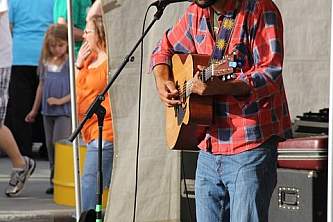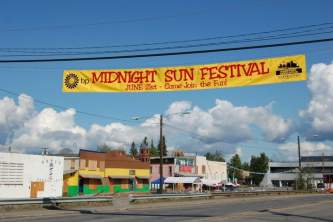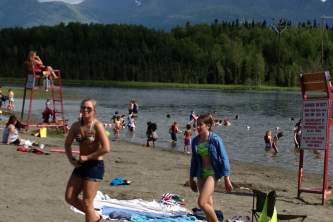Alaska's Top Adventure Travel Trips
Picture this: You’re hiking along a winding river while snow-capped peaks rise high above you. A bald eagle scans watchfully from the branch of a spruce tree. You pitch a tent on the riverbank, build a campfire, and as the glacial water rushes by, sleep out under the Alaskan sky.
If you’re looking for an amazing Alaskan adventure like this, you’ve come to the right place. This is what we believe to be the ultimate list of quintessential Alaskan adventures. Assembling it was no easy feat:
- The adventure had to offer stunning beauty (a high bar, by Alaska standards).
- It had to epitomize the very best of a certain activity (rafting, fishing, trekking), each of which offers hundreds of trip options.
- And it had to be easy to make happen, meaning there’s an air service or a guiding company to take you.
Ultimate List of Alaska Adventures
We believe these are the best adventures, but our list also represents the types of experiences you can find wherever you go in Alaska--sublime experiences that you’ll remember for a lifetime. They’re a way to truly experience Alaska and to connect with nature. After all, they get you out into a wilderness much like that of the Lower 48 during the time of Lewis and Clark.
We’re sure we’ve overlooked many other adventures almost as worthy as those on this list, so we hope to add to it over time. If you can think of others, we invite you to leave a detailed comment at the bottom of the page, including photos if you have them!
Show Map
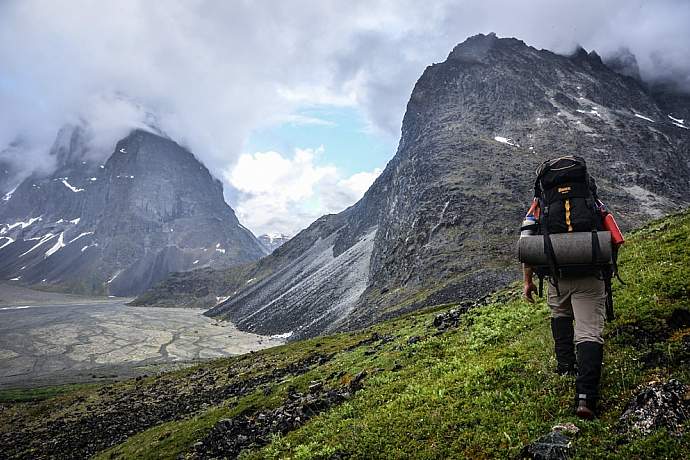
Backpack the Twin Lakes / Turquoise High Route
Explore the remote Chigmit Mountains
Few people visit Lake Clark National Park, because it’s not easy to reach; you can only get here by flying from Anchorage. Those who make the effort are rewarded with craggy, majestic mountains; lakes so turquoise blue you’ll think they’re overlaid with an Instagram filter; and a solitude so deep you could set up camp and not see another person for years. It was up here that Dick Proenneke, an Alaska mountain man, in 1973 authored "One Man's Wilderness: An Alaska Odyssey" from a neat but tiny cabin he hand-built on the shore of Twin Lakes. Proenneke is gone now, but his cabin has become something of a shrine in the heart of the park. Some people fly out to the lakes just to see it. But for a real Proenneke-like experience, backpack the Twin Lakes/Turquoise High Route, a quintessential Alaskan backpacking expedition. The rugged route through the mountains is no different now than it was in Proenneke's day. Glaciers, waterfalls, icy river crossings, infinite tundra, and wildlife both challenge and impress. Start your trip from Telaquana or Turquoise lake and walk in the footsteps of the Dena'ina Athabascan Indians who pioneered the first routes across this inspiring and ancient wilderness.
When to go: Mid-June to mid-September | Book it: Alaska Alpine Adventures
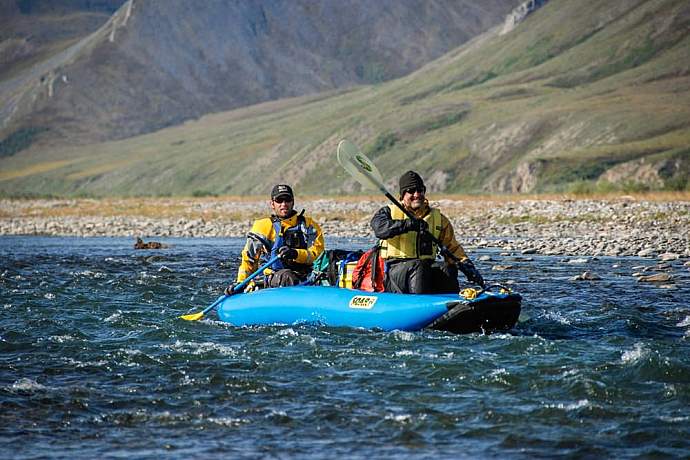
Paddle an Arctic River
Float the Kongakut from the Brooks Range to the North Slope
The Arctic National Wildlife Refuge is one of the last great wildernesses in North America. Caribou still roam this landscape the way buffalo roamed the plains of the American West in the 1800’s. And half a dozen hauntingly beautiful rivers here—like the Hula Hula, Marsh Fork, Ivishak, and Canning—beckon paddlers. But we’ve selected the wildlife-rich Kongakut River as the quintessential Arctic river trip. Sitting near the eastern edge of the 19-million-acre Arctic National Wildlife Refuge, the river is in the range of the 170,000-animal Porcupine Caribou Herd, and if you catch them at the peak of migration they offer an awe-inspiring experience in some of the most mind-blowing wilderness left on the planet. The Kongakut is so remote that just getting there is an adventure. You fly 300 miles north from Fairbanks in a small plane across the Arctic Circle to the Native community of Arctic Village, and then get on an even smaller plane to fly to a landing strip along the river. There, it's time to inflate canoes and begin a 10-day journey to the sea. There are no facilities along the way. You camp on river bars and hike tundra with animal trails as your only company. The Romanzof Mountains rip at the sky. Arctic char fill the river. A three-mile stretch of Class III whitewater challenges paddling skills, but the river is mostly fast but smooth-sailing Class II, which allows you to keep an eye out for the caribou, Dall sheep, grizzly bears, muskox, golden eagles, and many other migratory birds that inhabit the area in summer. As you near the coast, there's even the chance of an encounter with a polar bear.
When to go: June, August | Book it: Alaska Alpine Adventures or Chilkat Guides
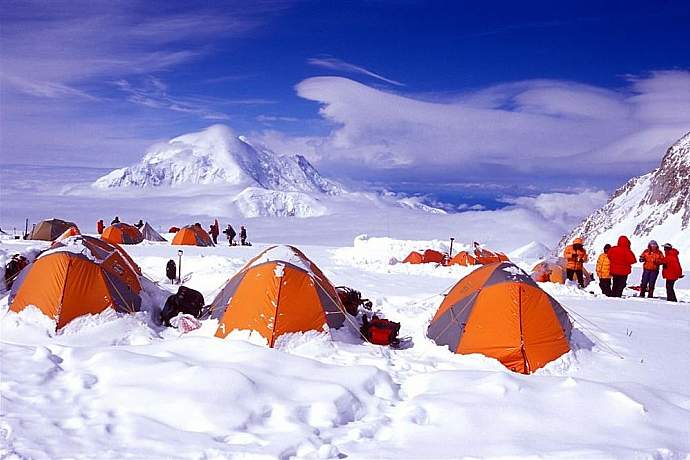
Climb Denali (formerly Mt. McKinley)
Set foot on the rooftop of North America
True adventurers yearn to reach the 20,310-foot, ice-covered summit of North America’s tallest mountain. It’s not only a classic, but summiting allows you to look down on hundreds of miles of wilderness, some of which have never felt the press of a human footprint. The climb is more strenuous than technical. The 13,000-vertical-foot trudge from base camp to the summit is greater than that of Mount Everest, the world's tallest peak. Everest is difficult because of the thin air above 20,000 feet. Denali is difficult because of the Arctic-like conditions. Deadly storms can materialize in any month. Judgment is required to survive, which makes it vital for the inexperienced to hire competent guides. They'll school you in glacier travel and crevasse rescue. You will be expected to arrive in the best shape of your life. With luck, you'll make the summit. (photo by joel)
When to go: End of April–end of June | Book it: Alaska Mountaineering School
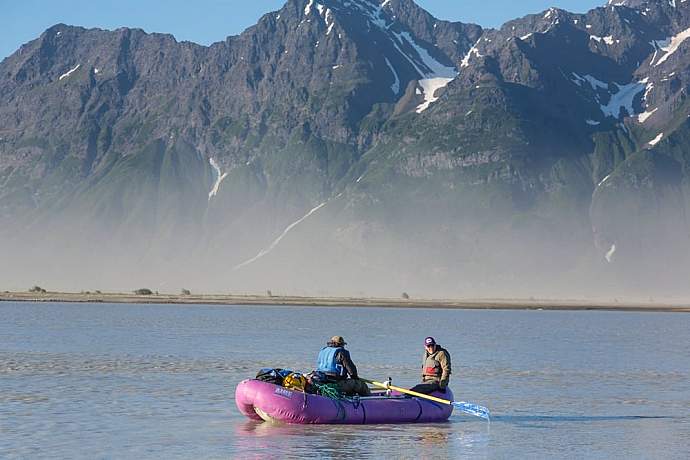
Float the Copper River
Greatest variety of any Alaska float trip
Draining the glaciers of the Wrangell, St. Elias, and Chugach mountains of Eastern Alaska, the Copper River churns to the sea at an average speed of 7 mph, carries some 750,000 cubic feet of sand and silt every day. Yet despite the turbid flow, the river is home to one of the world's best-known runs of salmon. A float down the river takes you through their homeland and a great variety of terrain. You run through a deep canyon and past historic collapsed railroad bridges, an abandoned tunnel, a 5-mile sand dune, and many side rivers that dump into the main flow. You’ll also see Miles Glacier, a glacial lake with massive icebergs floating quietly down the current with you, and travel past the face of Childs Glacier. Childs once calved at a rapid rate, due to the Copper’s swift current (10 mph at that point) ripping against its face in the summer. Its force has since churned up rocks in front of it and isn’t calving at the moment. But, glaciers are always changing and its possible it will calve again. You can raft the Copper River between mid-May and mid-September, with the best weather starting in June. And, if you hold out until September, you’ll be treated to some spectacular fall colors.
When to go: Mid-June through mid-September | Book it: McCarthy River Tours & Outfitters
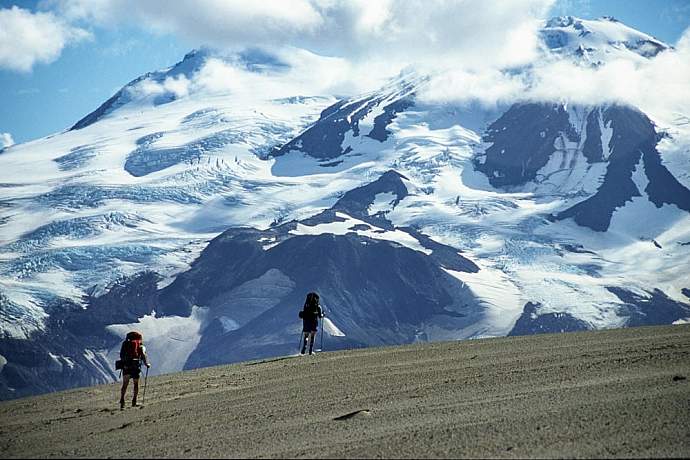
Backpack Katmai National Park
Experience the good, the amazing and the apocalyptic
Katmai National Park and Preserve in southwest Alaska offers a thoroughly unique landscape. Yes, the giant grizzly bears that flock to the Brooks River to feast on salmon (and sometimes wander through the campground) are amazing. But you’ll also find volcanoes that still steam. In fact, the park's "Valley of 10,000 Smokes'' is absolutely apocalyptic. Novarupta volcano exploded onto the scene here on June 6, 1912, sending ash 20 miles into the sky. Ash and pumice from the eruption rushed down the Ukak River valley at 100 mph to create the 40 miles of barren nothingness that would later come to be known for its estimated 10,000 steaming fumaroles. That number may be far less these days (nature has been steadily reclaiming the valley for more than a century), but the area is still pretty doggone spectacular. You can arrange to stay at Brooks Camp to watch the bears and take day trips to the valley on a National Park Service bus, or plan on backpacking the valley for up to a week or more. Either way, the fun starts at Brooks, which can be reached by Bush plane from Anchorage or the aptly named community of King Salmon on the Naknek River, just west of the park.
When to go: End of July to mid-September | Book it: Alaska Alpine Adventures
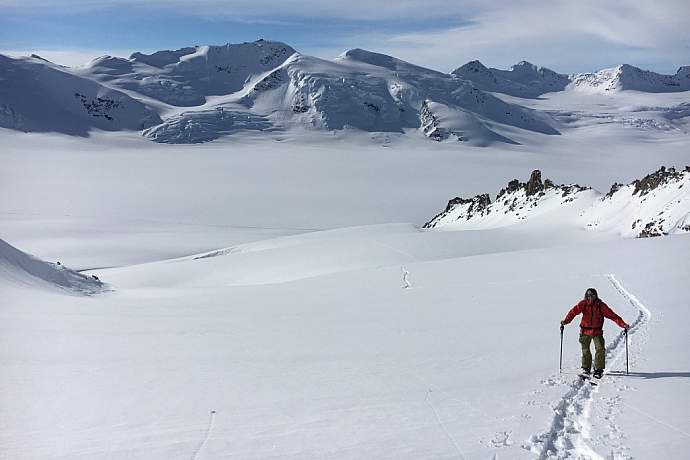
Backcountry Skiing by Plane
Schuss the Chugach Mountains near Valdez
Go backcountry skiing in a whole new way—the Alaska way. You’ll fly high into the mountains and land in a snowy wonderland, surrounded by jagged peaks and some of the most dramatic scenery you’ve ever witnessed. Then click in to your skis or board and set off, carving your own tracks into the planet’s fluffiest powder, on the longest descent of your life. Arrange for a pickup when you finish and you won’t have to worry about hiking, walking, or any logistics. Choose a day trip or opt for an immersive, multi-day outing to a glacier ski camp, where you could have the unique opportunity of skiing on a glacier. Whichever adventure you set out on, this is your chance to discover why skiing the Alaskan backcountry is truly a once-in-a-lifetime experience.
When to go: March - May | Book it: Tok Air Service
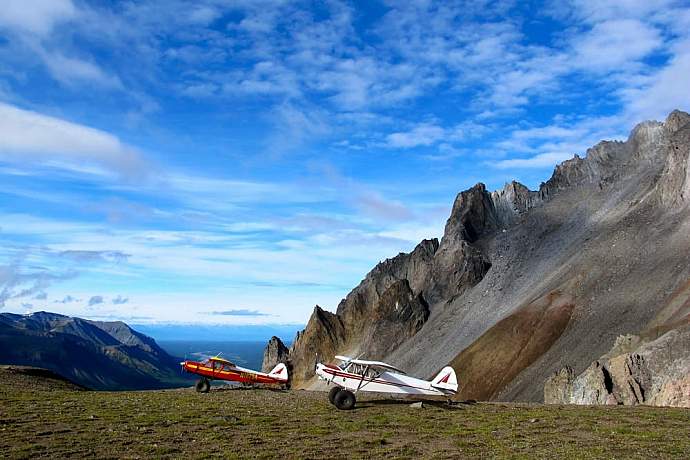
Explore the Wrangells with UltimaThule Lodge
Disappear into wilderness luxury in North America’s largest National Park
Ultima Thule Lodge is as close to nowhere as you can get on this planet while still experiencing all the comforts of the modern world. The exclusive lodge, tucked deep into the Wrangell-St. Elias National Park and Preserve, lies 100 miles from the nearest road. Luckily, it's got a big airstrip to welcome visitors. The lodge's five private cabins overlook the Chitina River; there, you’ll find handcrafted furniture and stained-glass windows. Your hosts custom-design daily adventures to meet your desires. You can take off in one of the lodge's planes and land at a private locations in the park for a day of hiking, fishing, wildlife viewing, or whatever you like. Back at the lodge in the evening, gourmet dining and a wood-fired sauna await. The menu leans toward local ingredients, like the world-famous salmon from the nearby Copper River. This adventure is not cheap, but it is one of the most unforgettable experiences you’ll likely ever encounter.
When to go: May – September, March – April for spring Skiing | Book it: Ultima Thule Lodge
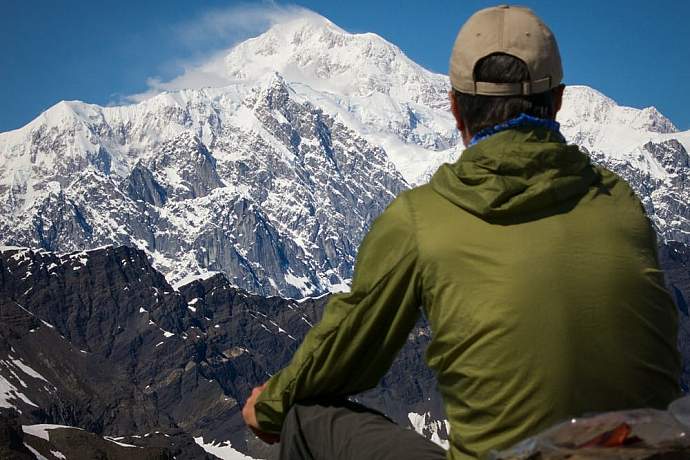
Camp at Backside Glacier Lake in Denali National Park
See this iconic park the way few travelers do
Most visitors to Denali National Park see the landscape from the confines of a park tour bus. But several years ago, the Park Service granted a concession for one company to operate a remote camp on the shores of an iceberg-laden lake that lies in a side valley, 25 miles up the Ruth Glacier. Experience this part of the park, which is accessible only by floatplane and visited by just a handful of travelers each year. It’s an area where you’ll be remarkably close to Mt. McKinley—less than 20 miles. Most places this close are covered by 1,000-foot-deep glaciers, but you’ll be in an enclave that features a moss-carpeted mountain next to a glacial lake in the shadow of Denali. On this 4-day, 3-night hiking and camping expedition that travels deep into the wilderness, you take off from Talkeetna and fly more than 20 miles up the spectacular Ruth Glacier before landing at a well-stocked wilderness camp. There you settle in to stay. Each day, you’ll set off with a small daypack and explore a new part of the park. You’ll even get the chance to walk on a glacier. Each night, you’ll return to your camp under the midnight sun, all the while surrounded by the mysteries of the tundra and the majesty of the Alaska Range.
When to go: Mid-June to early September | Book it: Alaska Alpine Adventures and K2 Aviation
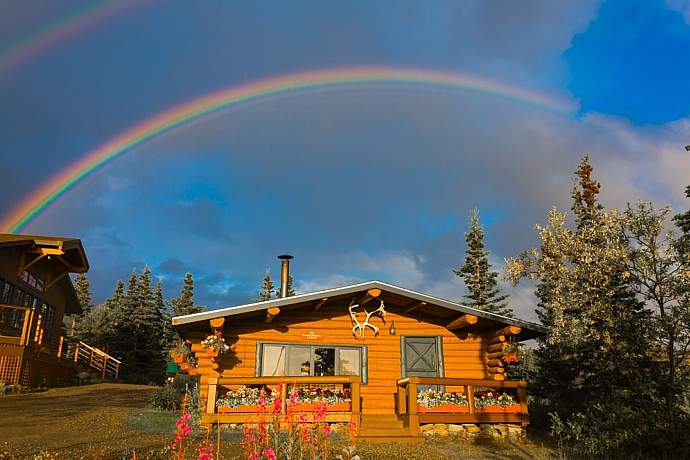
Take up Residence at Camp Denali
Wilderness lodge in the heart of Denali National Park
The best way to experience Denali is in Kantishna, 95 miles from the Park Entrance, as far back on the Park Road as you can go. There are only three lodges back here, so you’ll find solitude within view of Mt. McKinley—a very different experience from the Park Entrance. And Camp Denali was the first: It was founded by people who have become very involved in Alaska conservation, and it offers one of the world's great eco-lodge lodge experiences. Stay in one of the 18 rustic but comfortable log cabins, which have running water (though there’s an outhouse, and showers are a few minutes’ walk away). Most people join the guided hike, which gives you lots of insights into the area’s natural history, or use the lodge’s maps and go exploring by yourself. You can also take out a canoe on iconic Wonder Lake or use their fishing gear. Or of course, just relax with a book and a stellar view of Denali. Return home each day to gourmet meals. A three-day stay will give you a real taste of Alaska, but you may want to spend more time.
When to go: Early June to early September | Book it: Camp Denali
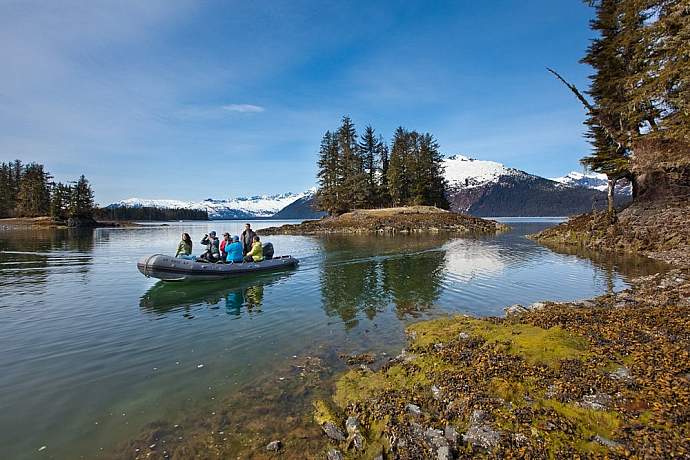
Cruise Prince William Sound with Discovery Voyages
The world’s ultimate small-ship glacier cruise
Global warming might be altering the 49th state, but not to worry, there's still plenty of ice. Prince William Sound alone boasts 150 glaciers. Dozens of them go all the way to tidewater. Most of them are, however, retreating. As they retreat, huge blocks of ice calve off their faces and fall into the ocean. The crack, the boom, and the splash of these events is dramatic. The ice that a small-boat skipper can gather from the resulting icebergs to chill a pre-dinner cocktail is a special treat. How often do you lift a toast with centuries-old ice? Discovery Voyages offers 5- to 7-day itineraries on board a 12-person yacht with expert guides and gourmet meals. And don't let the icy environment fool you. Despite the chilly waters, the Sound supports a rich marine ecosystem where you are almost certain to encounter whales, sea otters, Dall porpoise, seals, and other wildlife and fish. You might well find yourself paddling a kayak across crystal clear waters filled with milling schools of salmon happy to have made it home from the sea. On shore, expect to explore pristine beaches and hike through moss-draped rainforests on the way to wildflower-filled meadows.
When to go: May to mid-September | Book it: Discovery Voyages
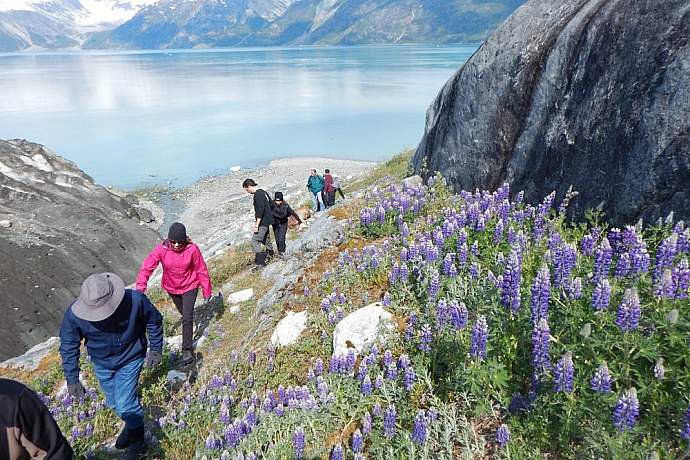
Cruise Glacier Bay with UnCruise Adventures
Small ships = BIG adventures
The misty waters of Southeast Alaska exude an otherworldly vibe, especially when you explore their straits and sounds by small cruise ship. Lose yourself in the beauty and mystery of this glacial domain on an 8-day excursion with UnCruise Adventures. Start off in Juneau, where you’ll get to know the crew and your fellow shipmates, likely as intrepid as yourself. Spend a day discovering remote waterways by kayak or paddleboard, and then journey on toward one of the most stunning national parks: Glacier Bay. This pristine wilderness sanctuary and UNESCO World Heritage Site was carved out over centuries by the Grand Pacific Glacier, which left behind a marine and terrestrial wonderland. Surrounded by gorgeous scenic backdrops, you’ll visit islands teeming with rare seabirds and take in massive tidewater glaciers spilling into the sea – all with expert guidance of a National Park Ranger, who will join you onboard reveal the secrets of this far-off corner of the world. Your ultimate destination is on the Gulf of Alaska coast: Sitka, a quaint and historic city of 9,000, has Native Tlingit and Russian roots and was where the transfer from Russian to U.S. ownership took place. Before you arrive there, however, you’ll venture through other straits and past miles of dramatic shoreline. Watch for puffins, eagles, whales, sea lions, harbor seals, otters, and bear along the shore throughout the cruise. It’s easier to get a closer look when aboard a smaller, quieter vessel. Icy Strait, Chichagof Island, Peril Straight, Sergius Narrows and Neva Strait are a few of the highlights. Hang out in secluded coves, explore intertidal zones from your skiff or kayak, and hike in the Tongass National Forest. If you’re feeling like changing things up a bit, you can travel this route backward, starting at Sitka and ending in Juneau.
When to go: May to mid-September | Book it: UnCruise Adventures
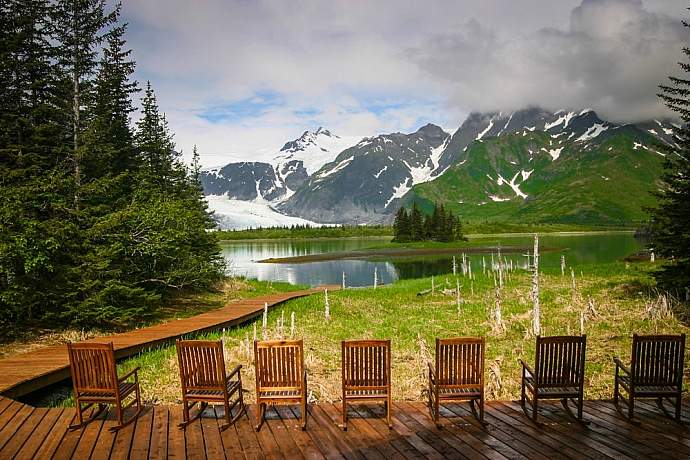
Stay at Kenai Fjords Glacier Lodge
Hike, kayak, and whale watch at the only lodge in Kenai Fjords National Park
When is a lodge more than a lodge? When it sits in a Native Alaskan wildlife sanctuary in the heart of a national park with full-on views of a gorgeous glacier. Here, the 16 cabins of the Kenai Fjords Glacier Lodge make up one of the best-situated wilderness eco-lodges in the country. Newly built, this lodge was sited with one prevailing thought in mind: Location, location, location. And it would be hard to find one better than this. Getting here is another treat. Transportation from Seward at the head of Resurrection Bay comes via a narrated Kenai Fjords glacier and wildlife cruise. There's usually plenty of wildlife to see, from mountain goats to black bears to killer whales, porpoises, sea otters, puffins and more. Once at the lodge, you can hike and kayak to get even closer to seals, otters, bears, and bald eagles, which are about as common here as geese on golf courses in the Lower 48. After a day of this, it's a pleasure to retreat to your own intimate, elegantly rustic cabin on the grounds of the lodge, where you’ll have a full-on view of the Pedersen Glacier and enjoy gourmet dining.
When to go: June to early September | Book it: Kenai Fjords Glacier Lodge
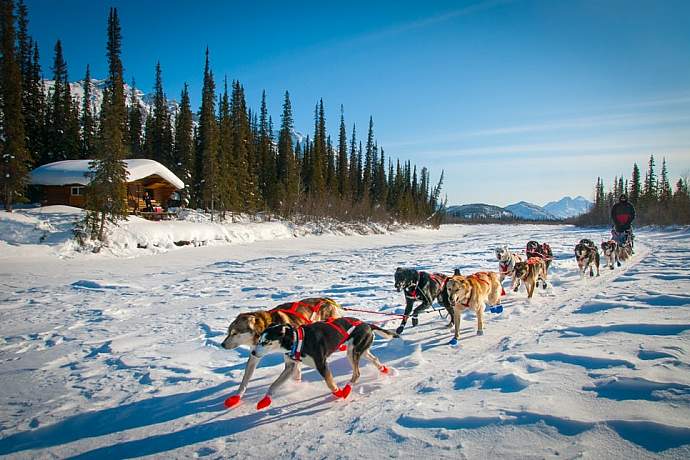
Northern Lights Viewing & Dogsledding in the Arctic
Run your own sled dog team beneath the northern lights
Alaska in winter is synonymous with snow, dogs, and the flickering Aurora Borealis. Think author Jack London or poet Robert Service, the bard of the north: "The northern lights have seen strange sights….'' Think the Iditarod Trail and Yukon Quest sled dog races. Think of yourself on the runner of that sled sliding across a vast wilderness. No, you can't run the Iditarod this year—that takes some training. But the premier way to experience this in Alaska is to fly to Iniakuk Lake Lodge, 60 miles north of the Arctic Circle in the Brooks Range, to undertake your own dog sled adventure with trusted guides. The plane ride, an adventure in itself, ends with a landing on skis, near your home for the days to follow. The dogs are waiting to tow you through snow-covered forest, tundra, ponds, or rivers. In fact, you can drive the dogs and run your own team. You pull the hook, unleash the team, and hear nothing but the slide of the runners and the panting of dog breath. If you want, you can take a break to cross-country skis or snowshoe. Or simply relax at the rustic but modern lodge at the edge of a 5-mile-long lake. It's a great place to view the northern skies on those nights when the aurora shows up to dance in multi-colored waves across the heavens. When these displays are at their max, they pack so much power you can hear them.
When to go: March and April | Book it: Iniakuk Lake Lodge
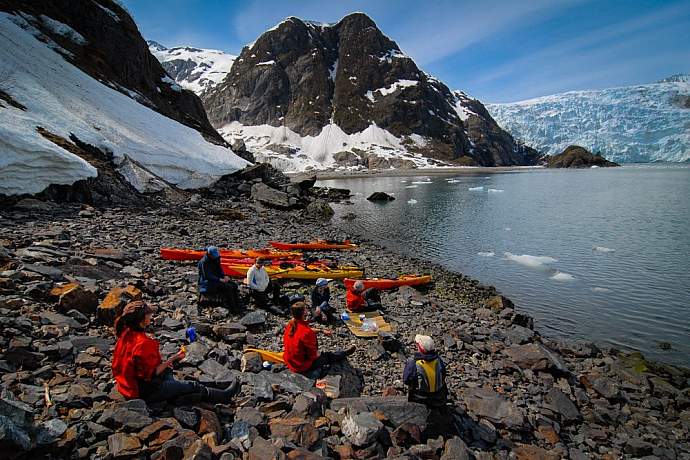
Kayak Aialak Bay
Slip silently across blue-green, glacier-fed waters and camp on secluded beaches
For thousands of years before the ships of white men arrived in the north, the Alutiiq Eskimos braved the surging Gulf of Alaska Coast from Kodiak Island south to the Kenai Peninsula and on to Prince William Sound. Skilled boatmen, they challenged big seas in tiny kayaks. An inexperienced paddler would be crazy to take on Gulf waters, but you can get a taste of kayak travel in sheltered Aialik Bay in Kenai Fjords National Park. Sunny Cove Sea Kayaking organizes trips for paddlers of all sorts here from Seward. You'll spend your days slipping silently across blue-green, glacier-fed waters and your nights camping on secluded beaches. The guides are trained naturalists who keep an eye on you and a companion in your two-person kayak, while explaining the ecosystem that supported the Alutiiq for thousands of years. They'll take you in close, but not too close, to calving glaciers; help you fish chunks of ancient ice out of the bay; and point out the wildlife that will make this 3- to 5-day wilderness adventure a trip you'll never forget.
When to go: Mid-May through August | Book it: Sunny Cove Sea Kayaking, Liquid Adventures – Sea Kayaking & Paddleboarding
Hike the Goat Trail
One of many classic hiking routes in the Wrangells
If you've already got some backpacking chops, and if you're not rattled by steep terrain, the "Goat Trail'' is a classic Alaskan hike. It’s not really a trail, but more of an historic route across the Wrangell-St. Elias mountains from the copper-mining town of McCarthy to the gold-mining town of Chisana. An air taxi dropoff at Skolai Lake high in the mountains makes it easier than it was in the old days. From there, you climb for about five miles to Chitistone Pass to start the descent through a world of rock and ice, down along the Chitistone River, past Chitistone Falls and the Chitistone Gorge to Glacier Creek. Outdoor writer Elisabeth Kwak-Hefferan was once moved to observe that "these 10 miles of pure Alaska experience are among the best 100 miles of trail in the whole national park system." That's a continent-size claim, but we can't argue. The hiking distance from the drop-off to the pickup is about 25 miles. It's considered moderate to strenuous, depending on how fit and experienced the hiker is and how much is being carried. The trip can easily be done in five days, but eight isn't too many. Bring a big memory card for your camera. The scenery—a cross between the Grand Canyon and the green Canadian Rockies—is the reason Kwak-Hefferan raved about this self-supported, on-your-own Alaskan adventure.
When to go: June to September | Book it: Wrangell Mountain Air
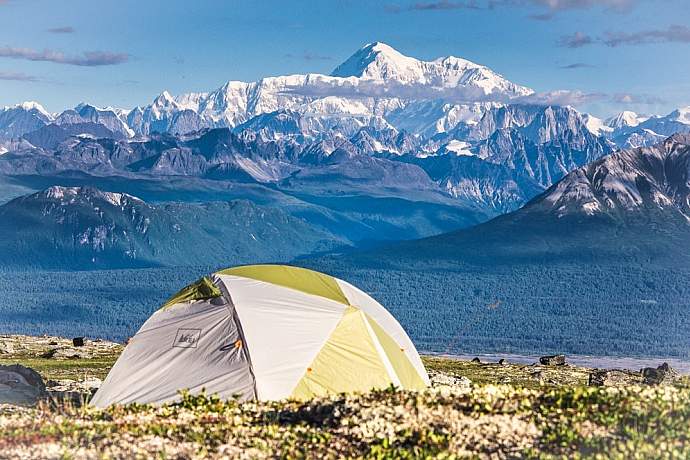
Backpack Kesugi Ridge
Hike the "other'' Denali Park
A rare combination of easy access, pristine beauty, solitude, and monstrous views make Denali State Park one of Alaska’s top adventure destinations. It’s a little-visited gem, and unlike the national park, the state park has an extensive trail system and no crowds. The Kesugi Ridge Trail stretches for 36 miles along a ridgetop between the Chulitna and Susitna rivers and takes you through spectacular scenery and prime wildlife habitat. But the real prize is to hike it on a clear day. Upon reaching tree line (at just 2,000 ft. here), vast panoramic views open up around you. The ridge is perfectly situated for viewing Denali, and you’ll feel richly rewarded for your efforts. On cloudy days, the scenery is still spectacular, but route-finding can be tricky along the more remote sections of the trail. Here in the state park you also have the option of going guided to get the most out of your trip–guides help you stay warm, dry, fed, and safe, but are also full of fascinating insights about the area and its wildlife. Nearly every visitor to the Denali area passes through Denali State Park and right by these trailheads, but almost all will pass right on by and miss it.
When to go: Hiking up to tree line is usually possible by June 1, but snowfields along the ridgetop persist until about June 15. | Book It: Alaska Nature Guides
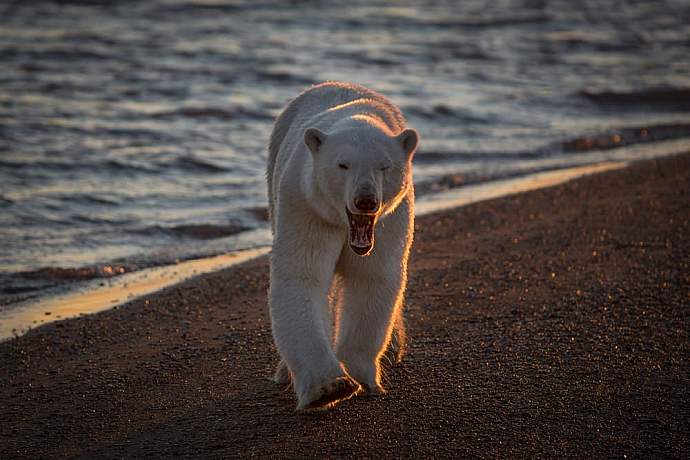
Ultimate Alaskan Photo Safari
Walk with the grizzly bears
No one trip offers massive gatherings of grizzly bears, caribou, polar bears, and gorgeous landscapes quite like Chulitna Lodge’s 10-day Photo Safari. The trip starts in Lake Clark National Park, where floatplanes land on the beach in front of the lodge to transport you across rolling hills of tundra and over Lake Iliamna (look out the window here for freshwater seals) to Katmai National Park, home of one of the area’s largest salmon runs. This, of course, is what attracts the bears, and it’s not uncommon for passing bears to wander within 20 feet of photographers here. Visitors might find themselves a little startled when a sow with young engages in the phenomenon of "cub parking,'' or leaving the young'uns close to people for protection from marauding male bears while mom wanders off to take a break. Next on the itinerary, small bush planes fly you northwest, where the seldom-visited Mulchatna Caribou Herd passes over the lichen-rich area. You spend some time spotting caribou from the air and the ground before traveling by boat and floatplane to see glacial lakes, massive waterfalls, and the tops of volcanoes. Then it’s up to America’s northernmost city, Barrow, and then on to a unique island, Kaktovik, where you witness polar bears by the dozen. As they unabashedly walk close to the small 6-person boat from which most of the viewing is done, you are thankful the guide is quick on the draw to back up before they get too close!
When to go: June-August | Book it: Chulitna Wilderness Lodge Retreat
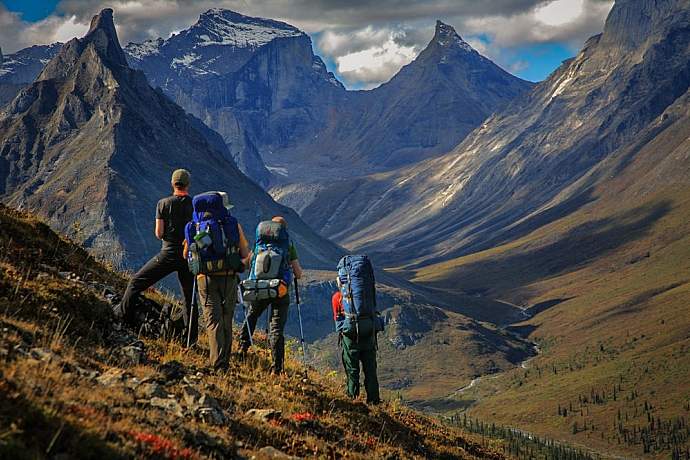
Backpack & Float Gates of the Arctic National Park
Trek in the Arrigetch, then float the Alatna
Even in Alaska, which is remote by Lower 48 standards, the Brooks Range is one of the more remote mountain ranges. And Gates of the Arctic is one of the ultimate backpacking destinations in Alaska. Walking is generally easy because there’s not much brush growing this far north, and to call the Arrigetch peaks spectacular is an understatement. Unclimbed until the 1960s, these granite spires, rising more than a mile high in the central Brooks Range, are the stuff of legend. You’ll start with a bush flight out of Fairbanks, then a floatplane flight into the park. You’ll then spend several days backpacking and hiking 6–10 miles a day among spectacular peaks, alpine tundra, and shimmering lakes, admiring the wide vistas and looking for caribou and grizzly bears.
After that, it’s time to get ready for a few days of rafting! Unlike the Alaska Range, whose rivers are fed by enormous glacial rivers, the Brooks Range’s glaciers aren’t as large, so the rivers run clear from their headwaters and are never as raging as those in the Alaska Range. You’ll float the Alatna River, widely recognized as one of the most beautiful in Alaska, running 20–30 miles per day in inflatable double kayaks. The river flows through deep canyons and is surrounded by high peaks, and along the way you’ll be looking for wolves, grizzlies, caribou, moose, and more.
When to go: End of July to end of August | Book it: Alaska Alpine Adventures
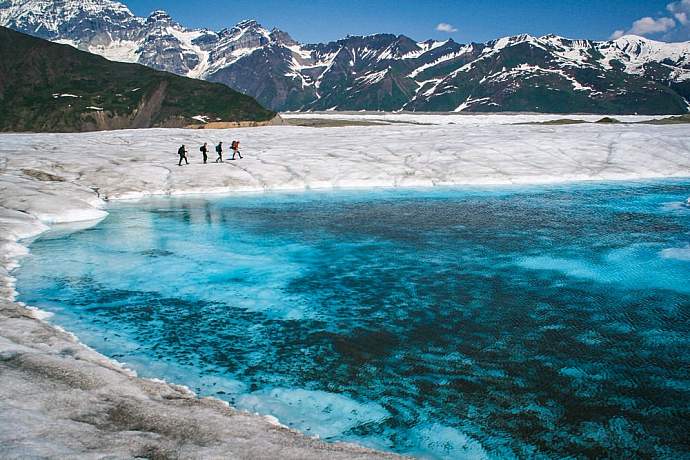
Glacier Trek the Root Glacier
Quintessential guided glacier hiking & climbing
At 13.2 million acres, Wrangell St. Elias National Park is the largest park in the entire National Park System, and about one-third of this grand park is made up of glaciers. One of the most dynamic of these is the Root Glacier, located right in the center of the park and next to the town of McCarthy-Kennicott. Of all the places you could try climbing with an ice axe and crampons, the Root Glacier is the best place to do it in Southcentral Alaska, because it’s so big and offers varied slopes and surfaces, from gentle to large ice walls. The glacier’s blue ice, turquoise pools, ice canyons, and bubbling moulins will fascinate you. And the glacier is nestled into one of the most spectacular natural surroundings you could imagine. If you only have a day in the area, join a full-day ice climb; if you’re lucky enough to have 2 or 3 days, an Advanced Climbing Skills Seminar will strengthen your technique and provide you with the skills and confidence to begin to ice climb on your own. Some examples of the potential skills covered are belaying, building anchors in ice, rappelling, vertical and overhanging ice climbing techniques, as well as crevasse rescue, self-rescue, pulley systems, and ascending your rope.
When to Go: May to September | Book It: Kennicott Wilderness Guides
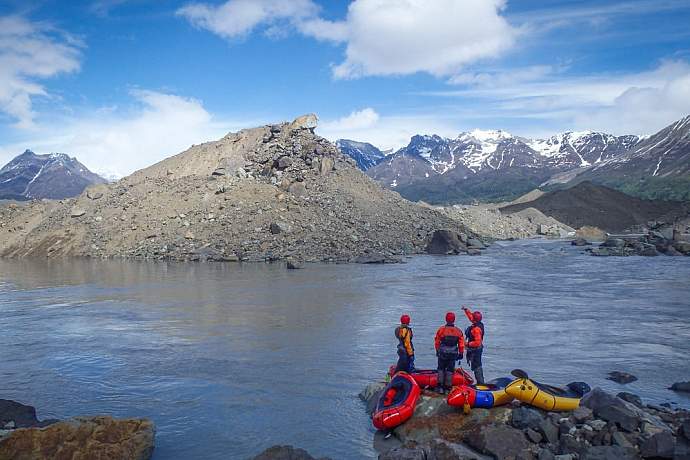
Learn to Packraft in the Wrangell St. Elias
Experience Alaska’s fastest-growing sport
Packrafting has revolutionized Alaska backcountry travel. In a state with thousands of rivers, these lightweight rafts, small enough to fit in your backpack, have made it possible to cross major swaths of wilderness. When you encounter a river crossing, you just blow up the boat, paddle across, and keep going. Or you can float downriver with the current for hundreds of miles, watching the forests and mountains pass swiftly by. Nothing gets you closer to river wilderness than packrafting. Whereas large inflatable boats perch you feet above the river, in a packraft you’re literally sitting right on the surface of the river (kept dry of course by the boat bottom), so you have an intimate vantage point to see waves, water, and passing forests. Unless you plan to enroll in one of Alaska’s universities, your best way to experience the thrill and beauty of packrafting is with Kennicott Wilderness Guides, near the town of McCarthy-Kennicott. They’ve spent the last five years developing a 2- to 3-day course that’s perfect for someone who’s never packrafter before. When you’re done, you’ll have the skills necessary to paddle the wilderness on your own! If you don’t have two days, join a half- or full-day packrafting group to get a taste of the fun.
When to Go: May to September | Book It: Kennicott Wilderness Guides
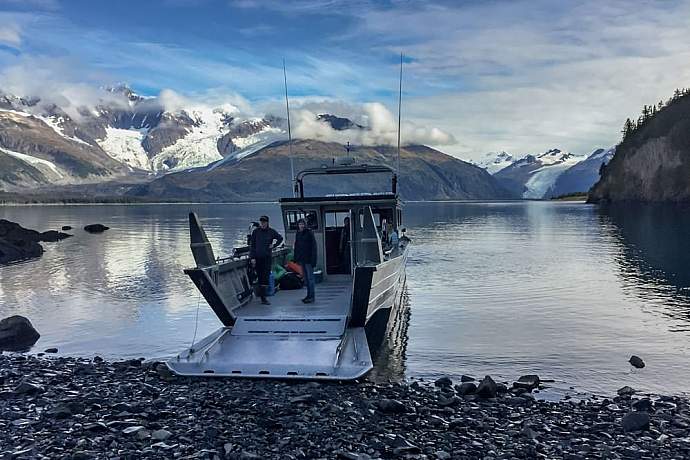
Kayak Barry Arm and Harriman Fjord
Sleep next to a glacier
Prince William Sound has the densest concentration of tidewater glaciers in Alaska, if not the world. Over two dozen of them flow to the sea within 100 miles of each other. The only way in is by boat or plane. Yet it’s reasonably close to Whittier, has a half-dozen of the longest glaciers, all in close proximity to each other. And where else in the world can you sleep on a beach next to a glacier, touch icebergs, walk on a beach, and kayak to see calving glaciers up close? In this 4- to 5-night kayaking adventure (you can also rent a kayak and go on your own), you’ll paddle from Barry Glacier into Harriman Fjord. Everywhere you look in this fjord there’s a glacier, several of which are tidewater. Camp at View Point beach, which is amply named with a phenomenal panoramic view. Enjoy day paddles and view sea otters and harbor seals relaxing on the icebergs. Or do a little hiking to get an eagle’s-eye view of this classic glacier fjord. You’ll leave this place with a sense of history and of the power of glaciation, as well as having experienced the area’s intense beauty and wildlife.
When to go: June to August | Book it: Rent a kayak and book a water taxi from Lazy Otter Charters.
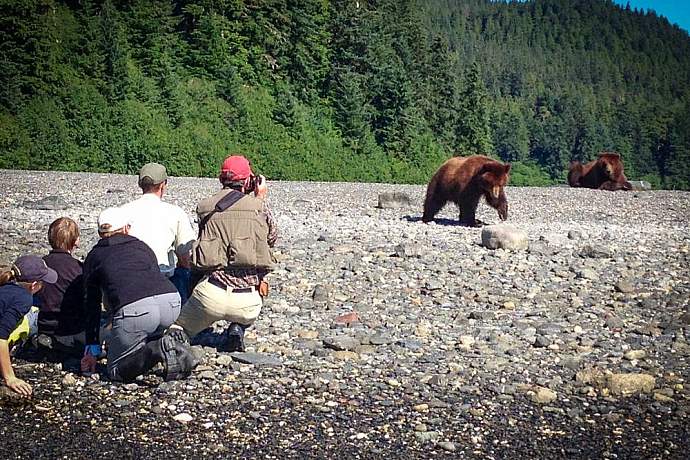
Explore the Pack Creek Bear Sanctuary
Amazing one-day bear-viewing adventure
Bear researchers know this as the place with the highest density of Alaskan brown bears recorded anywhere. Since the early 1930’s, the Pack Creek watershed has been the longest established bear sanctuary in Alaska, closed to all hunting and thus the home to generations of bears who have become habituated to peaceful visitors. Following their long hibernation period, bears emerge from their dens high in the mountains. They spend early summer on the Pack Creek beaches and stay through mid-September, when the last of the salmon have spawned. Pack Creek provides one of the most scenic yet least-visited places in Alaska to watch bears mate, raise young, and nourish themselves on a rich diet of plants, berries, and salmon. Ken Leghorn of Juneau has been going to Pack Creek every year since 1980, and started Pack Creek Bear Tours in order to share this phenomenal experience with others. The seven-hour day trip starts and ends with a stunning float plane flight over the northern Tongass National Forest, and includes more than five hours of watching and photographing bears along the beach estuary and deep in the old-growth forest. Visitors with more experience and time can rent a sea kayak and camping package from Above and Beyond Adventures in Juneau and spend a recommended three to five days exploring the area.
When to Go: May and early June and early July through early September | Book It: Pack Creek Bear Tours (day trip by plane and hiking) or Above and Beyond Adventures (sea kayaking and do-it-yourself camping)
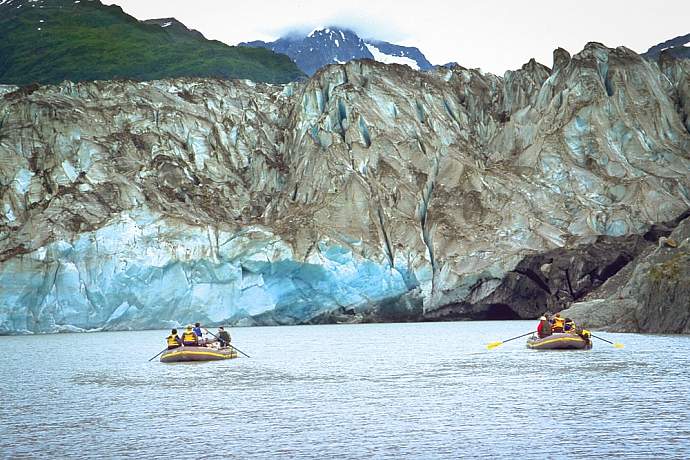
Raft the Tatshenshini RiverRoute
Scenic overload on this Canada-to-Alaska float trip
This is one of the most iconic wilderness raft trips in the world. Starting in the Yukon Territory, the Tatshenshini bisects two of the highest coastal mountain ranges on earth, the St. Elias and the Fairweather, before entering the Gulf of Alaska. Though it can be rafted in as little as a week, most people take 10 to 12 days to allow for “layover” camps from which to enjoy spectacular alpine hiking far above the river. The “Tat” is a fantastic introduction into the world of raft-based camping, as every day the Class III-IV river builds in volume and scenic intensity. Your trip passes from the lush forests of Canada into the post-glacial landscape of Southeast Alaska, providing a constant variety of natural history to explore. The six-mile-wide Alsek glacier deposits icebergs the size of battleships into your camp on Alsek Lake after tumbling from the snow-laden 15,000-foot peak of Mt. Fairweather, which (aptly enough) can only be seen on the clearest of days. Your final day of swift-water rafting concludes at Dry Bay (named for periodic low water, not atmospheric conditions) on the edge of the Gulf, where small planes must come to return you to the small Alaska towns of Yakutat or Haines.
When to go: June-August | Book It: Mountain Travel Sobek
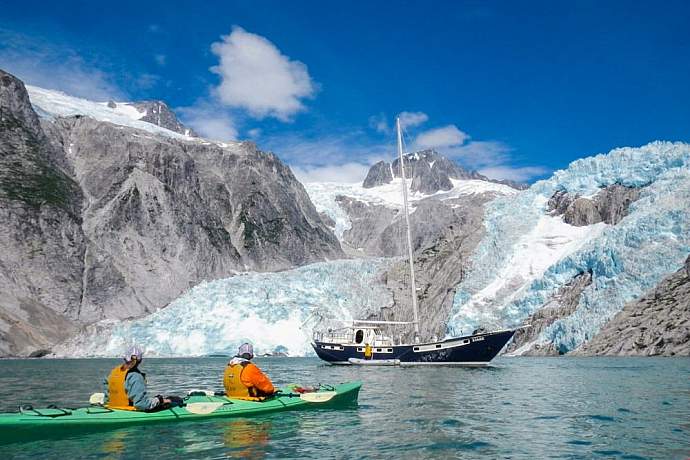
Kayak & Sail Through Kenai Fjords
Custom kayaking & small-ship adventure
Northwestern Kenai Fjords is a very special place—not only because of the amazing number of tidewater glaciers, but also because it’s remote and hosts towering granite cliffs. And you can see it on a 5- to 7-day “Mothership” trip with Kayak Adventures Worldwide, where you’ll also check out the wildlife of the Chiswell Islands. You’ll be living on a 62-foot sailboat, the STARR, with Captain Mike (who has been running boats in this area since 1987) and just 6 passengers—and kayaking every chance you get. You may spend the morning paddling up to the face of a calving glacier, and the afternoon seeing harbor seals resting on icebergs, or looking for whales on your way to the next kayaking spot. On shorter trips (3-4 days), you’ll head over to Aialik Bay, where you’ll try to visit all three tidewater glaciers there and see the waterfalls of Abra Cove. Trips are completely customizable; want to go for a long paddle, spend extra time looking for whales, or just relax on the boat? No problem. And at night, expect to anchor at some spectacular places, like Aialik Glacier, where you’ll sleep half a mile away from the face, so you’ll be close enough to see and hear it calve all night long.
When to go: May 20 – September 7 | Book It: Kayak Adventures Worldwide

